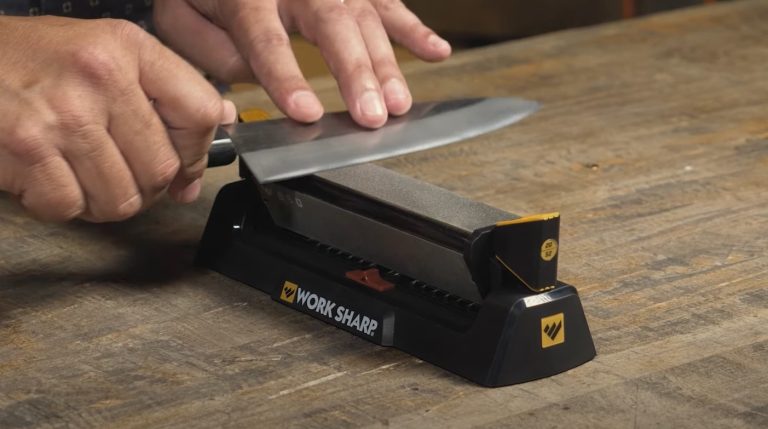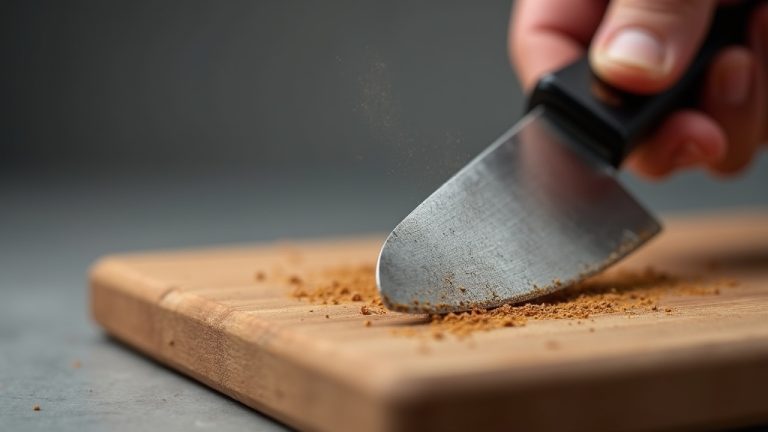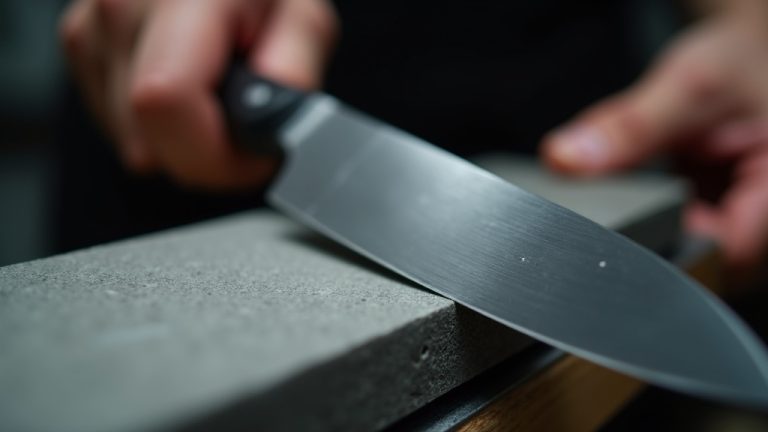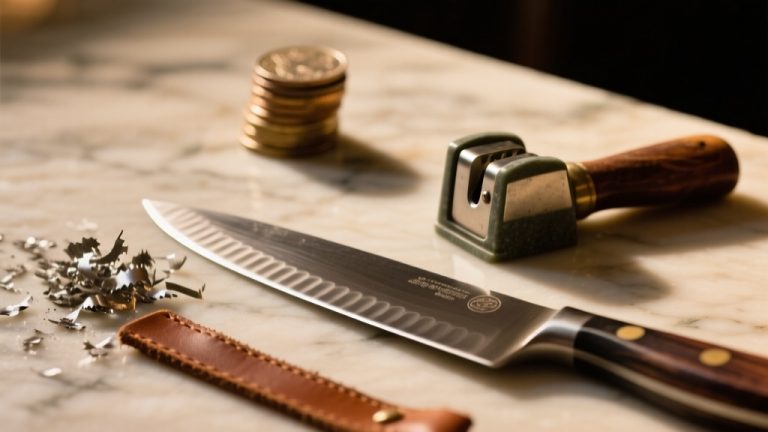How to Sharpen Serrated Knives: A Step-by-Step Guide
To sharpen serrated knives, use a tapered diamond or ceramic sharpening rod. Inspect the knife and note the angle of the bevel.
Insert the rod into each serration and apply short strokes, feeling for a consistent burr on the non-beveled side. After sharpening, refine each edge with light strokes, and finish by stropping with leather or denim for a polished edge.
Regular maintenance is key, and there’s more to guarantee your knives stay in top shape.
Key Takeaways
- Use a tapered diamond or ceramic sharpening rod for effective serrated knife sharpening, ensuring you match the rod to the size of the serrations.
- Inspect the knife and mark the edge angle; sharpen using short strokes to maintain the serration pattern without damaging the knife.
- Feel for a consistent burr on the non-beveled side while sharpening, indicating the edge is being properly refined.
- Clean the knife with mild soap and lukewarm water after use, drying it immediately to prevent corrosion.
- Conduct a performance test by slicing through bread or tomatoes to ensure the knife is adequately sharpened and performs well.
About Serrated Knives
Serrated knives are essential tools in any kitchen, designed specifically to tackle tough materials with ease. Their serrated edge features sharp, tooth-like protrusions, resembling a saw, allowing you to slice through bread, pastries, and tough-skinned fruits effortlessly.
Typically sharpened at a 20-degree angle, these knives excel in cutting without crushing the interior. Made from high-carbon stainless steel, they offer durability and corrosion resistance. The full tang design extends into the handle, ensuring balance and strength.
Serrated knives maintain effectiveness longer due to multiple cutting surfaces, providing an advantage over straight-edge knives. Moreover, regular maintenance with specialized sharpeners can enhance their longevity and performance.
Ergonomically designed handles provide a comfortable and secure grip, enhancing safety and control. Serrated knives are also versatile, serving outdoor and marine needs, making them an indispensable tool for various cutting tasks.
Essential Tools for Sharpening
To effectively sharpen your serrated knives, you’ll need a few essential tools that cater specifically to their unique design.
Start with various types of sharpening rods, as their abrasive surfaces play a vital role in maintaining the knife’s edge. It’s important to remember that serrated knives hold their edge longer than straight-edged knives, so restoration is more challenging when they do need sharpening.
Types of Sharpening Rods
When it comes to sharpening serrated knives, having the right type of sharpening rod is essential for achieving ideal results.
Ceramic honing rods are perfect for maintaining sharpness and fine-tuning serrations, while diamond-coated rods excel at reshaping severely dull knives. Serrated knives are designed for cutting tough and thick-textured materials, making them especially beneficial in culinary tasks.
Tapered rods are versatile, accommodating various serration sizes, making them ideal for different knife types. Although sharpening steels are primarily for straight-edge knives, they can also make minor adjustments on serrated edges. Honed rods are specifically designed for maintaining serrated edges.
Importance of Abrasive Surface
Understanding the importance of abrasive surfaces is crucial for effectively sharpening serrated knives. The right abrasive surface maintains the unique serration pattern while preventing damage. Traditional flat surfaces fail to reach into the serrations, risking over-sharpening. Here’s a quick overview:
| Abrasive Surface Type | Purpose |
|---|---|
| Tapered Ceramic Rods | Routine maintenance and polishing |
| Tapered Diamond Rods | Aggressive sharpening for dull knives |
| Flat Sharpening Stones | Not suitable for serrated edges |
| Specialized Tools | Preserve cutting ability |
Choosing the correct abrasive surface not only maintains your knife’s integrity but also extends its longevity. By using specialized rods, you guarantee each serration is sharpened effectively without compromising the blade’s performance.
Using Leather Strops
After selecting the right abrasive surface for sharpening your serrated knives, incorporating a leather strop into your routine can greatly enhance the sharpness and longevity of the blade.
Securely mount the strop to avoid movement, using a screw eye or paracord for stability. Always face the knife edge toward you and push away to maintain safety. Position the knife at a slight angle, similar to your sharpening angle, and stroke from heel to tip in a backward motion.
Regularly clean the strop surface to prevent metal buildup. Stropping not only removes micro burrs but also aligns the serrations, making it an essential step after sharpening with diamond or ceramic rods.
Safety Precautions to Consider
While sharpening serrated knives can enhance their performance, it’s important to prioritize safety throughout the process. Start by preparing your workspace: keep it clean, well-lit, and free from clutter. Use a non-slip mat under the cutting board and have a first aid kit nearby.
When selecting equipment, choose appropriate sharpening tools and avoid ineffective ones. Always wear cut-resistant gloves and closed-toe shoes.
Maintain focus and avoid distractions during sharpening. Regular sharpening maintains cutting efficiency, which is crucial for safe and effective use of serrated knives.
| Safety Gear | Workspace Tips | Equipment Choices |
|---|---|---|
| Cut-resistant gloves | Well-lit area | Sharpening rods specific to serrated knives |
| Closed-toe shoes | Non-slip mat | Avoid flat files |
| Safety goggles | Decluttered workspace | Consider electric sharpeners |
Locating the Bevel on Your Knife
Properly locating the bevel on your serrated knife is essential for effective sharpening.
First, examine the presentation side of the blade, which is the side that faces you when the knife is upright. Look for the angled grind that indicates the bevel; this is where the serrations are sharpened.
Examine the presentation side of your knife to locate the bevel and ensure effective sharpening of the serrations.
To make identification easier, you can use a marker along the edge this will wear away as you sharpen, revealing the bevel angle. Remember, the bevel width guides your sharpening angle and tool placement.
Typically, serrated knives are sharpened at a 15 to 20-degree angle. Understanding this will help you maintain the integrity of the bevel and achieve precise sharpening results.
Step-by-Step Sharpening Process
To sharpen your serrated knife effectively, start by gathering your essential tools.
You’ll need to guarantee you have the right equipment to get the job done properly:
- Diamond or ceramic sharpening rods
- Tapered rods for different sized serrations
- Electric sharpeners with serrated knife settings (optional)
- Finishing stones to remove burrs
- Avoid regular sharpening stones that can damage serrated edges
Next, inspect your knife, identifying serrations and marking the edge for angle adjustments.
Using a permanent marker to color the grinds will help you track material removal as you sharpen.
Use short strokes with the tapered rod to remove metal and feel for a burr on the non-beveled side.
Continue until the burr is consistent, then refine the edge by removing it with light passes.
Final Touches for a Polished Edge
As you finish sharpening your serrated knife, the final touches are essential for achieving a polished edge that cuts effortlessly. Use diamond or ceramic rods to refine each serration, applying light strokes at the correct angle to avoid over-sharpening.
Focus on removing any burr by stropping with leather or denim, ensuring your strokes move the burr away from the cutting edge. Regular maintenance with a ceramic honing rod will help keep your serrated knife in optimal condition.
After refining, inspect the knife for imperfections, and if everything looks good, perform a performance test by slicing through bread or tomatoes. This will confirm that your serrations are working efficiently.
Maintenance Tips for Serrated Knives
After each use, clean your serrated knife thoroughly to remove any food particles that could cause corrosion. Establish a regular inspection schedule to check for dullness or damage, ensuring your knife remains in top condition.
Timely sharpening enhances cutting efficiency and food presentation, making it an important part of your knife maintenance routine.
Cleaning After Use
A clean serrated knife not only looks good but also performs better in the kitchen.
To maintain your knife’s efficiency, follow these essential cleaning practices after each use:
- Rinse the knife thoroughly with lukewarm water.
- Use mild soap for cleaning; avoid abrasive cleaners or sponges.
- Dry the knife immediately with a clean towel, preferably microfiber or paper.
- Make certain the knife is completely dry to prevent water spots or corrosion.
- Never wash your serrated knife in a dishwasher to avoid damage from chemicals or heat.
Proper knife care is crucial to ensuring that your tools stay in optimal condition.
Regular Inspection Schedule
Regularly inspecting your serrated knives is essential for maintaining their cutting efficiency and safety. Check for signs of dullness, like difficulty cutting or tearing food.
If you notice this, it’s time to sharpen them. Aim for a sharpening schedule every 18-24 months, depending on usage. Additionally, hone your knife every three to four uses to keep the teeth aligned and sharp. Monthly checks are a good practice to guarantee effectiveness.
Proper storage is also crucial; storing your knives properly in a block or guard will help prolong knife lifespan. Always use wooden or plastic cutting boards to preserve the edge.
Frequently Asked Questions
Can I Use a Regular Whetstone for Serrated Knives?
You can’t effectively use a regular whetstone for serrated knives. Whetstones are designed for straight-edged blades and won’t fit into the unique grooves of serrations.
Instead, opt for specialized tools like tapered honing rods or diamond rods, which can reach each serration individually. These tools will help maintain the knife’s shape and sharpness.
Remember to follow proper techniques to guarantee your serrated knife performs at its best after sharpening.
How Often Should I Sharpen My Serrated Knife?
You should sharpen your serrated knife every 18 to 24 months for regular home use.
If you frequently use it, sharpen it sooner.
To keep it in prime condition, use a ceramic honing rod regularly, as this will extend the time between major sharpenings.
Always remember that serrated knives require less frequent sharpening compared to straight-edge knives, thanks to their unique design that helps maintain cutting efficiency longer.
Is It Safe to Sharpen a Serrated Knife at Home?
Absolutely, it can be safe to sharpen a serrated knife at home, provided you follow proper precautions.
Did you know that about 75% of knife injuries occur during improper handling? To guarantee safety, secure your knife in a vice grip, keep your workspace tidy, and always have a first aid kit nearby.
Use suitable tools like ceramic rods, and focus on maintaining the original serration angle to avoid damaging the blade.
What Are Signs That My Serrated Knife Needs Sharpening?
You’ll know your serrated knife needs sharpening when it struggles to cut through bread, creating excessive crumbs.
If slicing tomatoes becomes difficult or the knife slips instead of slicing, it’s time for maintenance.
Pay attention to how much pressure you’re using; if you’re applying excessive force, the knife’s dull.
Regularly check for debris in the serrations, as clogged edges can also hinder performance.
Keep an eye on these signs to guarantee peak cutting.
Can a Professional Sharpen My Serrated Knife?
Yes, a professional can sharpen your serrated knife. Many services offer specialized sharpening options tailored for serrated blades.
You can choose in-store or mail-in services, depending on your preferences. Providers like Eversharp Knives even offer same-day sharpening.
Stay Sharp – The Key to Efficient and Safe Cutting
With a little practice and the right tools, sharpening your serrated knives can become a simple task. Remember, “a sharp knife is a safe knife,” so keeping your blades in top condition not only enhances performance but also guarantees safety while cutting.
Regular maintenance, including proper cleaning and storage, will extend the life of your knives.
By following these steps, you’ll enjoy the benefits of well-sharpened, efficient knives for years to come.







